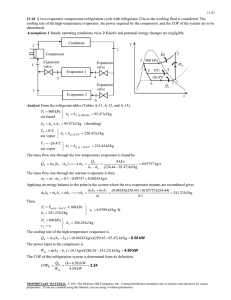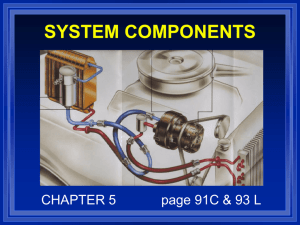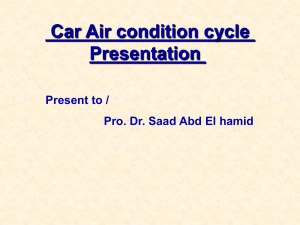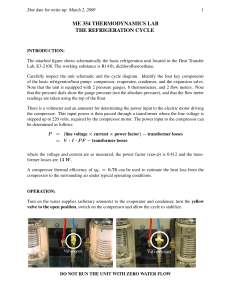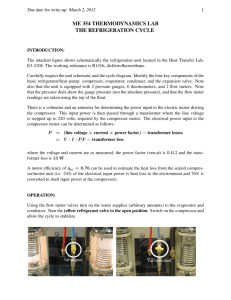Constant Pressure Expansion Valve Application - Purdue e-Pubs
advertisement
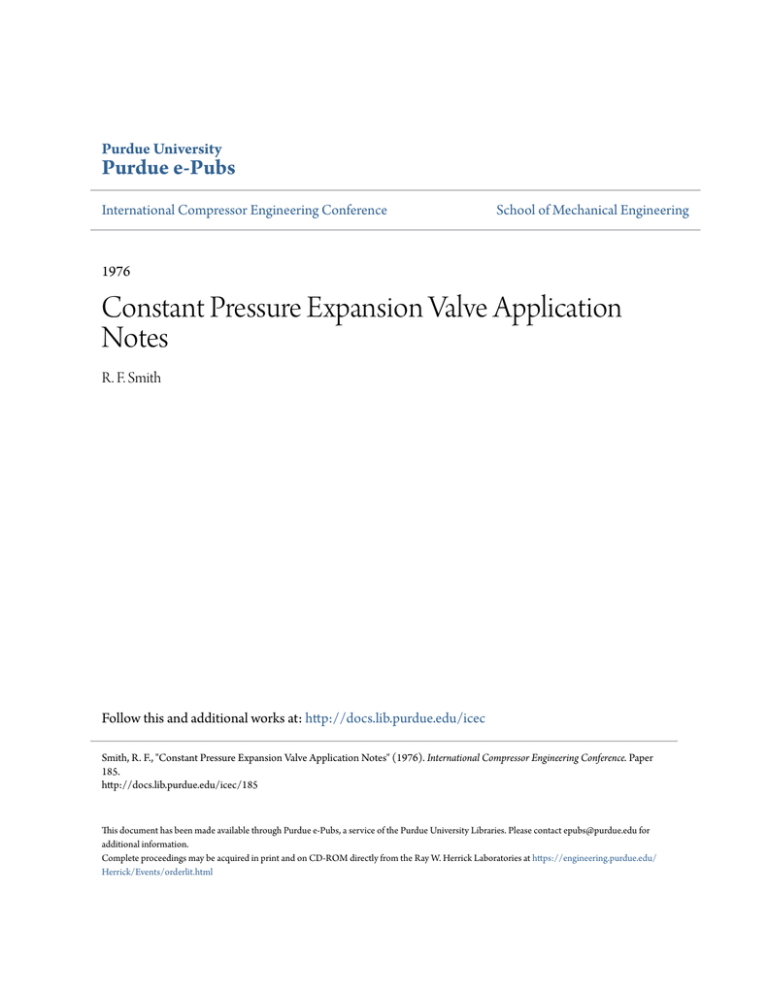
Purdue University
Purdue e-Pubs
International Compressor Engineering Conference
School of Mechanical Engineering
1976
Constant Pressure Expansion Valve Application
Notes
R. F. Smith
Follow this and additional works at: http://docs.lib.purdue.edu/icec
Smith, R. F., "Constant Pressure Expansion Valve Application Notes" (1976). International Compressor Engineering Conference. Paper
185.
http://docs.lib.purdue.edu/icec/185
This document has been made available through Purdue e-Pubs, a service of the Purdue University Libraries. Please contact epubs@purdue.edu for
additional information.
Complete proceedings may be acquired in print and on CD-ROM directly from the Ray W. Herrick Laboratories at https://engineering.purdue.edu/
Herrick/Events/orderlit.html
CONSTANT PRESSURE EXPANSION VALVE APPLICATION NOTES
ROY F. SMJ~H. P.E.
PRODUCT MANAGER
HEATING AND AIR CONDITIONING CONTROLS
SINGER, CONTROLS DIVISION
MILWAUKEE, WISCONSIN
ABSTRACT
The use of constant pressure (automatic)
expansion valves as the metering device
in vapor compressio n refrigerat ion cycles
employed in air conditioni ng systems offer
functional advantages which result in first
cost and operating cost benefits to the
manufactur ers and users of air conditioni ng
equipment.
of Home Appliance Manufactur ers) standard
RAC-1. For reference and comparison purposes the typical capillary tube performanc e
is shown on the same graph. This performanc e
data indicates that for a given system, with
a constant pressure expansion valve purposely
adjusted to duplicate the capillary tube
performanc e at rating conditions , the unit
will operate at higher suction pressure at
low load conditions (thus achieving freezeup protection ) and will operate at lower
suction pressure at maximum operating conditions (thus minimizing power consumptio n
and protecting the compressor against overload). The example used in figures 1 through
7 is a 1 ·ton room air conditione r (RAC) or
packaged ·terminal air conditione r (PrAC).
Constant pressure expansion valves would have
similar results when applied to any small
commercial or residentia l central air
conditioni ng unit through 5 ton R-22.
Operating performanc e is improved at typical
applicatio n air temperatur e conditions and
power consumptio n is reduced during peak
summertime demand periods. This control
concept should be of interest to utilities
as well as manufactur ers and users of air
conditioni ng equipment.
INTRODUCTION
The constant pressure or automatic expansion
valve is the fore runner of the thermostat ic
expansion valve and has been in production
since the early days of mechanical refrigeration. It was the second stage in the
evolutiona ry process from hand expansion
valves to thermostat ic expansion valves and
is still employed in a wide variety of air
conditioni ng and refrigerat ion applicatio ns.
The recent concern for energy conservati on
at minimum cost has greatly expanded the
interest in and demand for this simple and
reliable control valve. Constant pressure
expansion valves are basically pressure
regulating devices which respond to the
pressure at the valve outlet. Installed at
an evaporator inlet, as a device to control
refrigeran t flow, the valve meters the
refrigeran t flow to maintain a cons·tant
evaporator pressure during system operation.
FIGURE 1
TYPICAL PERFORMAN CE RAC OR PTAC
'109rll..~rwa~r
JODrOiii._ll"
,,.._.. 1/Jor..-u.tt-)
********
Constant Pressure (Automatic) Expansion Valves,
employed as the prime expansion device,
control the flow of liquid refrigeran t to the
system evaporator by opening on a decrease
in valve outlet pressure below the set
point. This results in the air conditioni ng
system performanc e shown in figure l, when
tested in accordance with AHAM (Associatio n
150
...,~,' J'V&J•W.r
'~t(M:M6r
(~~ ~- ~.l.t;:l-)
!MJI'F 1:111, ?'~FVfll .....r
IUI"r~~
(~'-La.4c:-tlir:~)
Through the use of system balance charts,
additional benefits of employing constant
pressure expansion valves on air conditioni ng
systems can be demonstrat ed. These additional benefits include: improved capacity and
operating efficiency through more efficient
compressor operation and increased evaporator
loading; and reduced first cost through
Figure 3 is the same compressor performance
data with the addition of condenser performance data. Condenser performance (broken
line) is shown as a family of curves with
each curve representing a constant condenser
entering air temperature. Each curve indicates condenser performance at constant condenser entering air temperature with variables
of capacity, suction pressure and condensing
pressure. For example: at the point where
125° condensing temperature intersects with
the 40° evaporating temperature, one will
note that the required condenser entering air
temperature to achieve this condition is
95°. At the intersection of '+5° evaporating
temperature and 70° condenser entering air
temperature a condensing temperature of
slightly over 100° should be found.
condenser surface reduction and/or selection
of lower capacity compressors. The poten·tial
cost reduction is more than sufficient to
offset the cost of the expansion valve and
increased evaporator loading. The effects of
changing the evaporator pressure at rating
conditions will be considered.
A complete system balance is constructed by
plotting capacity performance data for all
system components on one graph. A system balance plot consists of three families of curves,
one representing compressor performance, another represen·ting condenser performance and
the third representing evaporator performance.
All are plotted on co-ordinates of system
capacity and saturated suction temperature.
The family of curves representing evaporator
performance can be modified by ·the selection
of the expansion device to be employed in the
system. With these curves plotted for a
particular system, if any two of the following
variables are known, the remaining variables
can be determined: capacity, suction pressure
or temperature, evaporator entering air temperature. condensing temperature or pressure,
condenser enter-ing air temperature.
FIGURE 3
SYSTEM BALANCE PLOT
CONDENSER- COMPRESSOR CAPACITY
R-22
--
FIGURE 2
SYSTEM BALANCE PLOT
COMPRESSOR CAPACITY R-22
--;--·
·11j00~
I
··r·--,----:- ., ---·- --
18000
16000-'
100
l~flOO·
1961
18000-
16000
-I.
"168:
90
110
m
120
1W'I
291
-130
:
§_ 10000
§
14000
F·n
,-.
it
"'
8000
..
tiDl
110
22G
120
160
I
-!3D
2~7
i
140 "337 :
I
1--:
"i45
l59
CDNO.CONO
TEMURESS
(°F) (psig)•
CONO,-CONOj
TcMP!PRcSS
10000
196 I
~ -ilPOO
145 ·iio9'
12000
I
§ 1
3371
140
I-
r'--!
i
100
I
i - ; - - I -- i
I
168
-II
20000
90
'
·--(fJOO
loi:rj
I
I
I
4000
;
--~.
-~
I
I.
I
I
,.
2000
+
Figure I.J presents the same compressor-condenser curves with the addition of evaporator
capacity performance curves for a typical
evaporator using a capillary tube. Evaporator
performance is plotted at constant evaporator
entering air conditions. Figure L~ is a complete system balance with all three major
system components represented. At AHAM rating
conditions of 80° DB, 67° \\TJ3 evaporator entering air temperature, and 95° condenser entering air, one will note that the system
I
76 0 84 D IJ2l6
20
25
30
35
40
4\
--+---<
50
55
EVAPORAliNG TeMPERATURE I' Fl
Figure 2 is a family of curves representing
compressor capacity plotted against suction
pressure for various condensing temperatures.
Each curve indicates how compressor capacity
varies with suction pressure, at a constant
condensing temperature. This is typical
published compressor performance data.
151
capac ity is 11,20 0 BTU 's/hr. , the evapo rating
temp eratu re is 40° and the conde nsing temperatu re is appro xima tely 125°.
FIGURE 5
SYSTEM BALANCE PLOT
COND ENSE R - COMP RESSO R EVAPORATOR CAPACITY
R-22, CONSTANT PRESS URE
EXPANSION VALVE
FIGUR E 4
SYSTEM BALANCE PLOT
COND ENSE R - COMP RESSE R EVAPORATOR CAPACITY
R-22, CAPILLARY TUBE
90
20000
100
90 "!68
I
16BI,
1961
I
!
21.6
1961,
i8U00
120 1 26fr-l
I
138' 2~1"
!5000
I
·I4o:m1
145;)59"!
14000
11000
e
i=
1oooo
"~
8000
6000
4000
'
I
1000
SUcTION PRF.SSURE (psi!).
10
i
·=!
10
I
I
SUCTION-PfESSU{<E (ps~)
111 ~io 488 549 615 685 760 840 925
15
20
15
30 35
40
----;s---;---;-
EVAPORATING TEMP[RATUR[ (0 f)
377 430 488 54 9 615 685 760 8 .0 9 6
IS
10
25 30
35
40
45
50 55
F.VAPORATING T[MP[RATURE (Of)
Figur e 5 is a system balan ce plot with a
const ant press ure expan sion valve emplo yed
rathe r than a capil lary tube. Note that the
famil y of curve s repre senti ng evapo rator
perfo rmanc e at const ant enter ing air temperatu re cond ition s are group ed much close r
toget her. This occur s becau se the evapo rator
press ure is held relat ively cons tant, withi
n
the limit ation s of the valve diffe renti al
(typi cal cons·t::ant press ure expan sion valve s
requi re appro xima tely 1 psi chang e per .001
strok e). Some addit ional separ ation of the
low load cond ition curve s from the ratin g
cond ition curve is due to a norma l tende ncy
at low evapo rator load, in const ant press ure
expan sion valve appli catio ns, for liqui d
refri gera nt ·to colle ct in the evapo rator
rathe r than the conde nser. This resul ts in
flash gas in the system liqui d line which
in
tur-n requi res addit ional valve strok e to
main tain the press ure level desir ed to preve
freez e-up. The slope of the evap orato r enternt
~
ing air temp eratu re curve s is great er for
the
const ant press ure expan sion valve perfo rman
ce
due to the valve 's abili ty to open as sucti
on
press ure tends to decre ase in respo nse to
decre asing head press ure, thus main tainin g
relat ively stabl e evapo rator press ure and
temp eratu re. This resul ts in highe r system
The conde nser enter ing air temp eratu re and
the evap orato r enter ing air temp eratu re were
selec ted for these system balan ce chart s to
inclu de both AHAM and ARI (Air- Cond itioni ng
and Refri gerat ion Insti tute) ratin g, low load
(free ze-up ) and maximum opera ting cond ition
s.
In figur e 4 note that at AHAM maximum opera
ing cond ition s both the sucti on press ure andtthe head press ure have incre ased consi derab
ly
over that at ratin g cond ition s. At AHAM
freez e-up cond ition s the syste m repre sente d
has dropp ed in sucti on press ure to the point
where freez ing of the conde nsate on the
evapo rator coil will begin to occur . Note
also the slope of ·the evapo rator const ant
enter ing air temp eratu re lines ; as head
press ure drops , sucti on press ure drops rapid
ly and capac ity incre ase is limit ed. These obser vatio ns will be usefu l in comp aring
capil lary tube perfo rman ce in figur e 4 with
cons tant press ure expan sion valve perfo rmanc
e
in figur e 5.
152
capacity for low air temperai~res entering
the condenser. Note that the point representing AHAM maximwn operating conditions
occurs at both a lower suction pressure and a
lower head pressure than in the case of the
unit Gmploying a capillary tube. This results
in a reduced power consumption level at lligh
loads, when ·the demund on electric utili ties
for power is greatest and when the capillary
tube unit consumes the greatest amount of
power. This energy conservation is achieved
at only a slight loss in capacity at max.::
imim operating conditions when compared to
the ARI rating condition or to the capillary
tube unit.
FIGURE 6
SYSTEM BALANCE PLOT
CONDENSER - COMPRESSOR EVAPORATOR CAPACITY
R-22, CONSTANT PRESSURE
EXPANSION VALVE
2001JQ
90
168
100
196
110
216
120
160
130
297
140
137
)45
359 '
·!8000
16000
The improved capacity, as head pressure drops,
for a constant evaporator entering air
tempera·ture condition is a significant advantage for units operating in buildings with
the possibility of relatively high indoor
loads combined with low outdoor ambient. This
can occm' in installations with high loads due
to people, lighting or equipment operating in
a conditioned space. Also, in installations
where the building is unoccupied during'daylight hours. Here the entire structu~'e is
soaked in high temperature and SL1nlight during
the day, and the air conditioning unit is not
turned on until the evening hours when the
outdoor ambient has dropped.
lj
:··-r·
I
;<!Qee
I
At AHAM low load cooditions in figure 5 both
the suctioo pressure and head pressure are
higher than the corresponding point for capillary tube operation in figure L~. Graphically then, this point represents the freezeup protection which constant pressure expansion valves are capable of providing by maintaining the evaporator pressure at a high
level regardless of the head pressure and
evaporator entering air temperatures. While
the freeze-up protection is accomplished by
over-feeding the evaporator, this over-feeding is much less severe than that which occurs
when the evaporator on a capillary tube unit
freezes up. Through careful selection of
valve orifice size the ol!er-feed can be held
to the minimum J.'equired to just preven·t freeze
up at the minimum air temperatu~e conditions
required by the customeJ.'. In effec·t the
slight overfeed which occurs during operation
at low load, for freeze-up protection, is
protection against severe flood-back which
could occur if ·the evaporator were allowed
to freeze-up. Liquid overfeed reaching the
compressor can be minimized by avoiding free
draining evaporator designs, an accumulator
is not required.
1·
SIJ(;[ION ARESStJRE(pslgj
31.8 Jl 7 410 48 8 54 9 615 68 5 76.0 84 0 92:6
10 15 1'o z's
40 45 so 55
EVAPORWNG T~MPERATURE (°F)
10 JS
rating conditions for the capillary tube unit
and, is achieved without any increase in head
pressure at maximum operation conditions.
Thus the unit rating could be upgradeu with
only the addition of evaporator surface and/
or evaporator air flow rate. Of course, the
manufacturer could also elect to reduce the
compressor and/or condenser size to keep
the system capacity at the original level
while reducing the factory cost of the unit
through the use of a smaller compressor and
less condenser sur'face. The condenser surface reduction could be accomplished several
ways: reducing the number of fins per inch,
reducing the tubes in the face, or reducing
the diameter of the ·tubes in the condenser
for example from 3/8 to 5/16. Reducing the
number of tubes or tube diameter (Prime
surface) will result in additional savings
thru reduced refrigerant charge. Freeze-up
protection of course is still provided thus
eliminating the need for cross ambient type
thermostats and allowing the use of a low
cost bimetal inbuilt thermostat.
Figure 6 represents the same unit with a slightly largeJ.' evaporator and/or increased evapora·tor clir flow rate. The cons·tant pressure
expansion valve is adjusted to a higher pressure level at the AHAM rating condition. At
rating conditions the evapora tol' temperature
is now 46°, the capacity
12,6000 BTU/hr. and
.
the condensing temperature 128 . The compares
to 40°, 11,200 BTU/hr. and 125° respectively at
Figure 7 is a typical system balance plot
(same! as figure 6) with the compressor watts
input included as a separate family of curves
on the lower poJ.•tioo of the diagram. Using
this plot the BTU/wa·tt hr. ratio was determined for the AllAM freeze-up, rating and maxi-
153
Temperature and humidity control is improved
and the stress on starting components is
reduced by the elimination of thermostat
cycling for freeze-up protection.
FIGURE 1
SYSTEM BALANCE PLOT
CONDENSER- COMPRESSOR EVAPORATOR CAPACITY
R-22, CONSTANT PRESSURE
EXPANSION VALVE
The off-cycle unloading feature is usually
provided in the valve to allow the use of
the same low starting torque compressors
employed with capillary tubes.
10000
* * * * * *
Reprinted for the conference with the permission of ASHRAE. This paper appeared in
the April 1976 issue of ASHRAE Journal.
18000
16000 I
!4000'
12000'
1600
11100 .
10
15
20
15 30
35 40
EVAPORATING TEMPERAfURE [° F)
45
50
mum operating conai tions <ma a comparison
made between the capillat'y tube unit and
the automatic expansiui1 valve unit with the
following resul·ts, indicating that ·the
automatic expansion valve application is
operating on a higher efficiency portion of
the compressor performance curve at rating
and freeze-up conditions due to the higher
suction pressure:
EER - (BTU/WATT-HR)
AHAM
RATE
FREEZE
AXV
8.87
12.92
6.69
CAP. TUBE
8.24
10.92
6.76
MAX
While operating slightly less efficiently at
maximum operating conditions the power consumption, in absolute terms is lower for the
AXV unit (1600 watts vs. 1700 watts).
Additionally, a system employing a constant
pressure expansion valve is not a cri·tically
charged system. The valve will compensate
automatically for over and under charge
situations.
154
